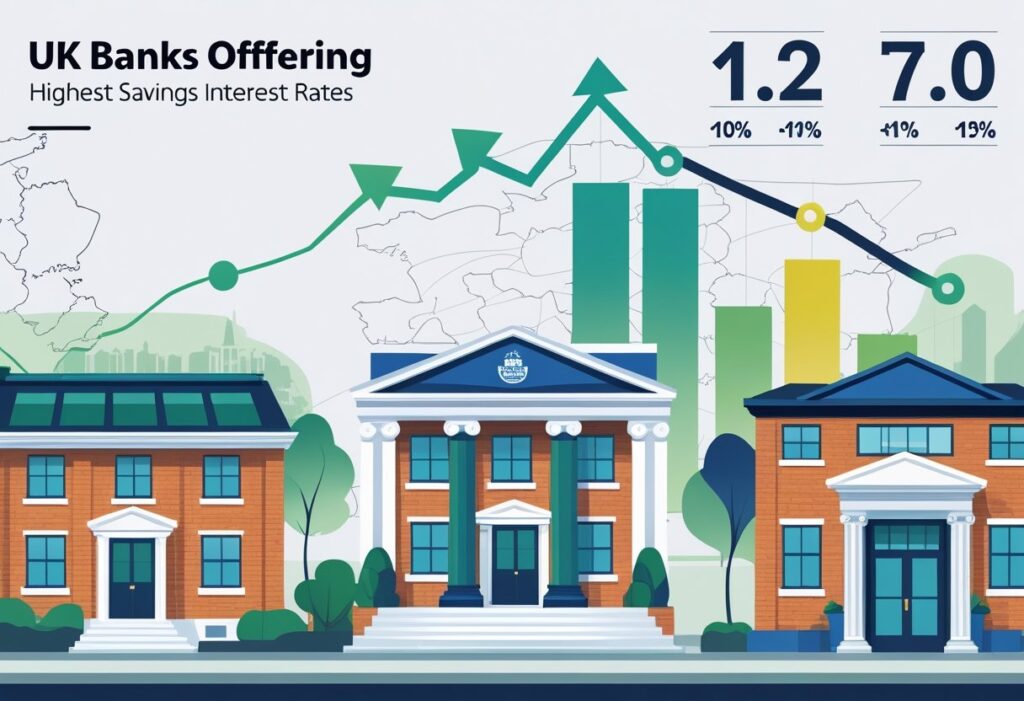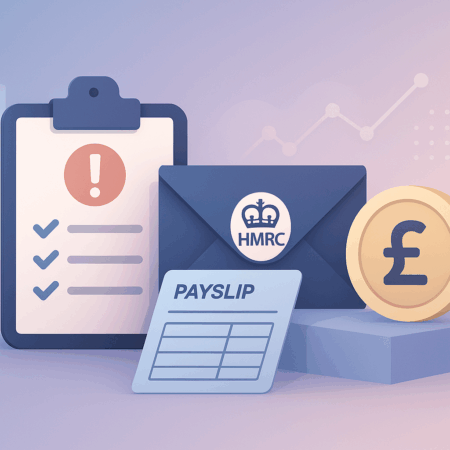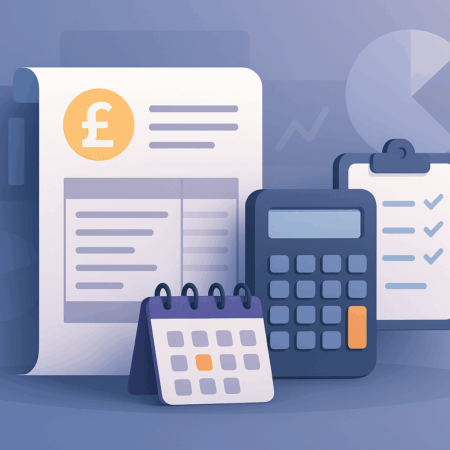Finding the best savings interest rates in the UK really can make a difference to your money’s growth. Plenty of banks now compete with tempting rates, with some easy-access and fixed-rate accounts paying up to about 4.8% as of 2025.
That means savers get higher returns while keeping their cash safe and pretty accessible.

Different types of savings accounts suit different needs. Some folks want instant access, while others prefer locking their money up for a better rate.
Comparing options like cash ISAs and specialist savings accounts helps you discover which ones give the best tax perks and interest.
You’ve got to understand the rates and terms to make a solid choice. Banks update their offers constantly, so staying on your toes can help you snag better returns without extra risk.
Key Takeaways
- The highest savings interest rates in the UK are close to 4.8%.
- Account types differ in access and tax advantages.
- Comparing options regularly keeps your savings growing safely.
Banks With the Highest Savings Interest Rates in the UK

Some banks just pay noticeably more than others on savings. It depends on the account, the term, and what’s happening in the market.
Knowing these differences helps you pick accounts that actually grow your money.
Current Top-Rate Savings Accounts
By September 2025, the best easy-access savings accounts in the UK are offering around 4.75%. Fixed-rate bonds are a bit lower but more stable, with rates near 4.52%.
You’ll usually find the highest rates come with strings attached—like notice periods before you can withdraw, or locking your cash in for a set time.
Some banks throw higher rates at regular saver accounts, but those want you to pay in monthly.
Both big high street banks and new challenger banks are fighting for your attention with these rates.
Comparison of Interest Rates Among Banks
Interest rates definitely aren’t the same everywhere. Here’s a rough idea:
| Bank Type | Easy-Access Rates | Fixed-Rate Bonds | Notice Accounts |
|---|---|---|---|
| High Street Banks | Around 4.3% | Up to 4.5% | About 4.0% |
| Challenger Banks | Up to 4.75% | Around 4.4% | 4.1% |
The best interest accounts usually come with some restrictions, like how often you can take money out or how much you can put in.
It’s worth looking at the details to make sure the account fits your life.
How Rates Are Determined
Savings interest rates mostly follow the Bank of England’s base rate. When the base rate moves, banks tend to adjust what they pay.
Banks also watch each other closely. Challenger banks, trying to win customers, often push their rates higher.
Inflation and the economy play a part too, as banks try to balance profit with being competitive.
Rates change all the time, so it pays to check what’s out there before you jump in.
Types of Savings Accounts With High Interest Rates

High-interest savings accounts fall into a few main types. Each one has its own rules about when and how you can get at your money.
Some let you take cash out anytime, others want you to give notice, and some lock your savings away for a set period.
These differences affect both flexibility and what you earn.
Easy Access Savings Accounts
Easy access accounts let you take your money out whenever you want, with no penalties. They’re best if you want flexibility and need to get at your cash quickly.
Rates tend to be lower here, but some banks are still offering around 4.75% in 2025.
Watch out for withdrawal limits or rules that might cut your interest if you break them.
You’re covered up to £85,000 under the FSCS. These accounts are great for emergency funds or savings you might need soon.
Notice Savings Accounts
Notice savings accounts ask you to give a heads-up before withdrawing, usually 30 to 120 days.
You’ll often get a higher rate than with easy access, since the bank gets some predictability. Rates can hit 4.8% or more, depending on the term.
They’re a balance—better interest, but you’ll need to wait if you want your cash. Pulling out early can mean delays or losing interest.
Notice accounts work well if you can stash money for a while but don’t want to commit for years.
Fixed-Rate Bonds
Fixed-rate bonds lock your money away, usually for one to five years. The rate stays the same the whole time, and it’s usually the highest you’ll find.
In 2025, you might see rates around 4.5% or a bit more, depending on the term.
Early access? Forget it, unless you’re okay with penalties.
These are for people who won’t need their savings in a hurry and want a guaranteed return.
They’re also protected up to £85,000 by the FSCS. Before choosing, make sure you can really leave your money untouched for the whole term.
Comparing Cash ISAs and Tax-Free Savings Options
Cash ISAs let you earn interest without paying tax. There are a few types, each for different savings goals.
Other tax-free allowances and government schemes can also affect how much interest you actually keep.
Understanding the rates, limits, and rules makes a difference in picking the best option.
Best Cash ISA Rates in the UK
Cash ISAs pay interest tax-free. In 2025, top rates range from about 4.3% to 5.17%, depending on who you go with and what type of ISA it is.
Fixed-rate Cash ISAs usually pay the most, but you’ll need to lock your money away for one to five years.
Easy-access Cash ISAs let you take money out, but the rates are usually lower.
You can put up to £20,000 in ISAs each tax year, spread across all ISA types. A lot of people pick Cash ISAs for safe, tax-free growth without the stress of investing.
Understanding the Personal Savings Allowance
The Personal Savings Allowance (PSA) lets you earn some interest tax-free outside ISAs. Basic rate taxpayers get up to £1,000, higher-rate taxpayers get £500, and additional rate taxpayers get nothing.
This applies to interest from regular savings accounts, bonds, and other products that aren’t ISAs.
If you’re likely to go over your PSA, it’s worth considering ISAs for the extra tax-free space.
ISAs have no limit on how much interest you can earn tax-free, unlike the PSA.
Lifetime ISAs Explained
Lifetime ISAs are for saving towards a first home or retirement, with some nice tax perks. You can put in up to £4,000 a year, and the government chips in 25%—so, up to £1,000 extra.
If you withdraw for a first home or after age 60, it’s tax-free. Otherwise, there’s a penalty for early access.
Lifetime ISAs are a good add-on to regular Cash ISAs, but the rules are stricter.
| Feature | Cash ISA | Lifetime ISA | Personal Savings Allowance |
|---|---|---|---|
| Max Annual Contribution | £20,000 | £4,000 | N/A |
| Tax-Free Interest | Yes | Yes (+govt bonus) | Limited (£1,000 or £500) |
| Access Flexibility | Easy or fixed access options | Restricted with penalties | Unlimited on non-ISA accounts |
| Purpose | General savings | Home or retirement savings | Applies outside ISAs |
Specialist and Niche High-Interest Savings Accounts
Some savings accounts are designed for specific needs or groups. They tend to offer higher interest but usually come with extra rules.
These accounts might work for you if you want steady growth, are saving for a child, or just want to earn something on your everyday cash.
Regular Savings Accounts
Regular savings accounts pay you more for making monthly deposits. Usually, you’ll need to pay in a set amount—maybe £25 to £500 each month.
Interest rates are higher than on normal savings, but often only for the first year.
Banks like these accounts because they encourage good saving habits.
They often limit withdrawals, so you’ll need to be okay with leaving your money alone for a while.
If you’re after steady, disciplined saving and want a guaranteed return up to around 4.5%, these can work well.
Children’s Savings Accounts
Children’s savings accounts help parents or guardians put money aside for kids. They often pay tax-free interest and keep the money locked away until the child turns 18.
Some accounts let the child take over as an adult, which is a nice way to build financial awareness.
Rates vary, but banks compete hard for long-term savers.
You’ll usually find restrictions to stop early withdrawals, and a parent or guardian has to manage the account until the child is older.
Interest-Paying Current Accounts
A few current accounts pay interest, so you can earn something on your day-to-day money.
The rates aren’t as high as specialist savings accounts, but they beat accounts that pay nothing.
You’ll often have to meet conditions—like paying in each month or keeping a minimum balance.
These are good if you want to keep your cash accessible and still earn a little.
Some banks offer bonuses for meeting the rules, but these can change, so keep an eye out.
Interest usually gets paid monthly or annually.
Factors to Consider When Choosing a High-Interest Savings Account
Picking the right high-interest savings account means thinking about how easily you can get your money, what you need to open the account, and how interest gets taxed.
All these things affect how convenient and profitable the account will be.
Access and Withdrawal Restrictions
Lots of high-interest accounts limit withdrawals. Some let you take money out anytime, while others—like fixed-rate bonds—lock it away for a set time.
Notice accounts want advance warning, usually 30 to 90 days, before you can withdraw.
Check for withdrawal limits to avoid fees or losing interest.
Regular saver accounts, for example, often don’t let you take money out at all during the term.
If you need access, easy-access accounts make more sense, even if the rates are a bit lower.
Account Opening Requirements
Banks often set rules for opening high-interest accounts. You might need a minimum deposit, have to be a certain age, or even be a new customer.
Some accounts want monthly payments to keep the rate.
Fixed-rate bonds usually want a lump sum upfront, and you can’t add more money later.
Read the terms carefully, or you might end up moving money around and dealing with penalties.
Tax Implications
Interest from savings accounts gets taxed, but the Personal Savings Allowance helps. Basic-rate taxpayers can earn up to £1,000 interest tax-free, higher-rate get £500, and additional-rate taxpayers pay tax on everything.
Cash ISAs keep your interest tax-free, no matter how much you earn.
Pick an account that fits your tax situation to keep more of your returns.
Tax rules can change, so it’s worth checking them now and then.
Maximising Your Savings Interest in the UK
If you want to get more from your savings, pick your accounts and strategies carefully.
A few smart moves can boost your interest without extra risk.
Strategies for Boosting Returns
Fixed-rate bonds usually pay more than easy-access accounts. Locking money away for a year or more gets you a better rate, but you lose flexibility.
Splitting your savings between different accounts can help. Maybe keep some cash in an instant-access account for emergencies, and put the rest in a fixed-rate bond for longer-term growth.
Check how often interest gets paid—monthly or quarterly compounding can make a difference.
Go for accounts with no fees and solid rates. Banks sometimes offer bonuses or higher rates for new customers or big deposits, so watch for those deals.
Staying in the loop on offers and rates is one of the simplest ways to make your savings work harder.
Switching Accounts for Better Rates
Interest rates bounce around a lot these days. If you want your savings to work harder, moving your money to a higher-paying account can really make a difference.
Banks love to tempt new customers with flashy introductory rates. But those rates usually vanish after a few months, leaving you with something much less exciting.
Before jumping ship, it’s worth checking the fine print—notice periods, withdrawal limits, all that stuff can make a difference.
Comparison websites and monthly-updated rate tables make it easier to spot the best deals. You can even set up automatic alerts for rate changes, so you don’t miss out when it’s time to switch.
Frequently Asked Questions
Savings accounts in the UK come in all shapes and sizes. Interest rates depend on the account type, how long you’re willing to lock your money away, and which provider you choose.
Some accounts let you dip in and out whenever you like, while others reward you for sticking around with higher interest.
What are the top-performing savings accounts in the UK for higher interest rates?
Right now, you might find easy access savings accounts offering up to 5% interest. Fixed-rate bonds usually land around 4.5%.
Regular savings accounts sometimes go as high as 7%, though you’ll probably have to stick to a monthly deposit limit.
Which UK banks offer the best rates for long-term savings?
Building societies and specialist banks often lead the pack with long-term fixed-rate bonds. You’ll see rates between 4% and 4.8% if you’re willing to lock your money away for one to five years.
Can you identify any challenger banks in the UK that are outperforming traditional banks in savings interest?
Some challenger banks and fintechs really do outshine the big high street names, especially for easy access and fixed accounts.
They tend to run everything online, which seems to help them offer better rates by cutting costs.
What are the requirements to qualify for the highest interest rates on savings accounts in the UK?
Getting the top rates isn’t always straightforward. Sometimes you need to put in a minimum deposit, or open a linked current account.
A lot of the best deals are just for new customers, or they have age limits. Regular savers accounts usually want you to commit to a monthly deposit if you want that headline rate.
How do introductory interest rates compare among the leading UK savings accounts?
Introductory rates can look fantastic at first, but they’re usually only around for 3 to 12 months. After that, the rate often drops—sometimes by quite a bit.
It’s worth double-checking what you’ll actually get after the intro period ends, so you don’t end up disappointed.
What strategies can be employed to maximise interest earnings from savings accounts in the UK?
You can open several accounts—think fixed-rate bonds or easy access accounts—to catch the best rates. Honestly, it pays to keep your options open.
Set up regular monthly deposits. Shop around for deals; don’t just stick with what you know.
Keep an eye on rate changes. If you spot a better account, move your money. Why settle for less?









